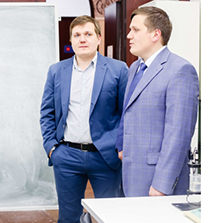
This prestigious international award has been given to young scientists from all over the world since 1991; 2017 marks the first time it goes to scientists from Russia.
The Ulrich Award, named after famous researcher Donald R. Ulrich, was established in 1991 and is given once every two years to young scientists for outstanding achievements in sol-gel chemistry. Throughout the years, its winners came from France, USA, Spain, Germany, Italy, Japan and the Netherlands. The candidates and the winner are chosen by the Board of the International Sol-Gel Society. The main criteria for selection of candidates are their existing contribution to the field of sol-gel technology and the area of their future research.
This year marks the first time that the award is granted to scientists from Russia – the winners of 2017 Ulrich Awards are Vladimir Vinogradov, Head of ITMO University’s International Laboratory "Solution Сhemistry of Advanced Materials and Technologies" (SCAMT) and Alexander Vinogradov, head of ITMO’s Biochemistry cluster. The ISGS Board announced the winners on June 5. The award ceremony will take place at the International Sol-Gel Conference that will be held in Brussels in early September. There, Vladimir and Alexander Vinogradov will deliver a special report on research conducted at SCAMT Laboratory.
“Here at ITMO University we’ve managed to create a research center for cutting-edge sol-gel technology in a very short amount of time. There are more and more young researchers here whose works are published in highly-rated scientific journals and, importantly, some of our research has already become a part of real economy. These include an innovative firefighting technology based on sol-gel chemistry and a highly refractive surface for application on holographic film,” – says Vladimir Vinogradov.
The International Laboratory "SCAMT" was founded at ITMO University in October 2014. Back then it only took up a small 30 m2 room and employed just four researchers. Nowadays it is a multi-profile chem-bio research cluster in a 2 km2 space. At the center, dozens of students, including foreign ones, conduct research in sol-gel chemistry. This fall, as head of laboratory Vladimir Vinogradov notes, the number of researchers will increase to 80.
What makes the sol-gel method so good?
The sol-gel method is one of the simplest and most versatile ways of producing nanomaterials and systems – usually non-organic ones. Despite being invented a while ago, this method remains highly popular and has a number of advantages. It does not require any special equipment, such as high-temperature of high-pressure mechanisms, because the synthesis occurs directly in the solution. This also allows to reliably produce material with certain textures by way of regulating the initial conditions of the synthesis.
Scientists today create many materials using the sol-gel method: solar batteries, ultracapacitors and self-cleaning coatings. Due to the method’s simplicity and versatility, these nanotechnologies are easily commercialized. According to statistics, approximately 20% of all nanotech materials on the market are made using sol-gel technology, explains Vladimir Vinogradov.
For example, at ITMO University’s International Laboratory SCAMT, a group of scientists are using sol-gel technology to develop a unique type of ink for jet-printing parts of solar panels as commissioned by a client from Israel. Just recently, the laboratory reached an agreement with a company from Moscow to begin work on the development of new fire extinguishing systems, also based on sol-gel material.
In addition, the lab also actively conducts research on inorganic pharmaceuticals, jet printing and a number of functional nanomaterials. One of the projects is gradually entering its commercial stage: the scientists have begun a pre-clinical trial of a magnetic thrombolytic – a magnet-controlled drug intended for treatment of thrombosis that consists of a porous magnetite framework containing a thrombolytic agent. The research shows that a solution of nanoparticles of the new drug, drawn to a thrombus with use of magnet, could, in theory, break down blood clots 4000 times more effectively than the currently existing thrombolytic drugs. The invention is also going to reduce the required dose many times over and avoid a variety of side effects.
(author Elena Menshikova)